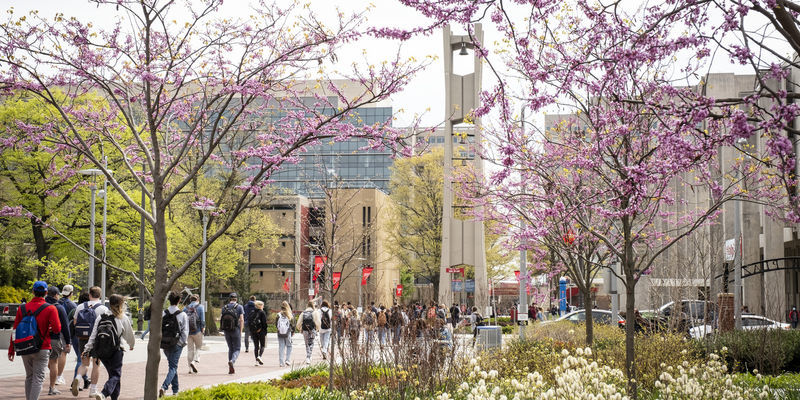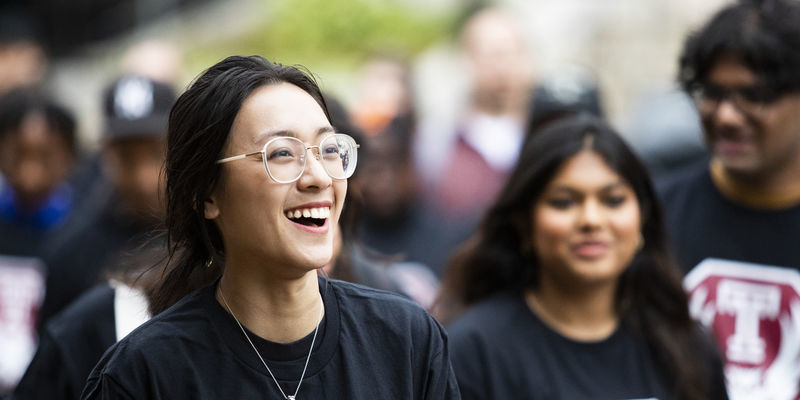Record-breaking applications to Temple propel surge in deposits
Undergraduate deposits from first-year admitted students are up 29% compared to last year.

With the fall semester approaching, Temple University is on track to welcome its largest class in several years. The Class of 2028 is also shaping up to be one of the most richly diverse classes in Temple’s history.
As of June 10, the university has received more than 5,600 undergraduate deposits from first-year admitted students. This is up 29% from the total number of deposits that the university received last year, and this number excludes any students that may come to Temple under the University of the Arts teach-out. Temple has also received an additional 1,340 deposits from graduate students, which is up 12% from last year.
The increase in deposits comes after the university received a record-breaking number of applications for the fall 2024 semester. Not every student who has made a deposit will ultimately matriculate, but the rise in deposits is the latest evidence of Temple working to address its priority of strengthening enrollment.
“We are immensely excited to see so much interest in Temple University,” said Senior Vice President and Provost Gregory N. Mandel. “This serves as further affirmation that Temple offers a world-class, accessible education, and the fact that so many students have committed to making this university their home for the next four years reflects that.
“Faculty and staff across the Temple community have worked tirelessly to help us arrive at this point,” Mandel added. “Our Division of Enrollment Management, under the leadership of Vice Provost Jose Aviles, and colleagues across divisions, schools and colleges have been willing to try new approaches and think outside the box. As we head toward fall, we are in such a strong position today because of the tremendous work done by all these people.”
Temple’s increase in undergraduate deposits can be seen across several key demographic areas. Both out-of-state and in-state deposits are up considerably. Deposits from the city of Philadelphia are up, too.
The increase can be attributed to several factors, including a renewed focus on in-person recruitment, more opportunities for prospective students and families to visit campus, and innovative programs like Temple Promise. Temple Promise, which was launched in February, is a new last-dollar financial aid grant program that is designed to make a Temple education more accessible and affordable for all qualifying admitted first-year, full-time students residing in Philadelphia County with a family adjusted gross income of $65,000 or less.
While Temple Promise has played a role in the uptick in deposits, other factors have also been key. This year, Temple increased recruitment visits to schools by more than 80%. Visits to campus by prospective students and their families also increased by 59% while visits by admitted students increased by 47%. When meeting with students, university representatives delivered a consistent message: Temple is one of the nation’s top public research universities, and students who come here are taught by world-class faculty.
“When it comes to college recruitment efforts, relationship-building is so important, and this is one of the areas where I believe we have performed exceptionally well this year,” Aviles said. “When you meet with a prospective student, either here on campus or at their high school, it is so much easier for them to see how Temple can open the door to a world of limitless potential and endless opportunity. They can then feel comfortable in knowing that Temple is the right choice for them.”
This boots-on-the ground approach was especially important this year given the challenges that have arisen with the revised Free Application for Federal Student Aid (FAFSA) form.
“In traditional circumstances, the college application process can be daunting for prospective students and families. This year, it has been even more challenging given that many families had trouble completing the new FAFSA form and have not yet received financial aid,” Aviles said. “Now, more than ever, it is important to help demystify the application process for students, and I believe we were able to do that here at Temple.”
One way Temple accomplished this was by offering on-site admission decisions for local first-generation and low-income students.
In recent years, the diversity of the Temple community has been well-reflected within its student body. For instance, last year, for the fourth straight year, Temple welcomed a record percentage of students of color.
While the university will not know the actual makeup of the Class of 2028 until students arrive on campus later this summer, there are several positive indicators that suggest Temple will once again welcome a group of students that is geographically, ethnically and socioeconomically diverse.
- Deposits from international students are up 64% versus last year. This continues to be an area of growth for Temple as international diversity within last year’s Class of 2027 was up 21% over the previous year.
- Deposits from Black students are up 70% while deposits from Hispanic/Latinx students are up 31% compared to last year. Currently, students of color make up 61% of all deposits, compared to 57% last year.
- Deposits from Philadelphia residents are up 59%, further affirming Temple’s role as Philadelphia’s public research university.
- Total deposits from residents of Pennsylvania are up 20%.
- Deposits from out-of-state students are up 41% compared to last year.
- The academic credentials of the deposited class have also increased as measured by high school GPA.
- Temple’s acceptance rate has also slightly decreased by two percentage points.
Over the next several weeks, Temple’s Division of Enrollment Management and departments across the university will work diligently to meet students where they are to help ensure that they can join the university as part of the Class of 2028 this fall.
“We are happy with these positive enrollment indicators, but there is still work ahead of us,” Aviles said. “We must continue to work with families and students to support their aspiration to join us this fall.”


